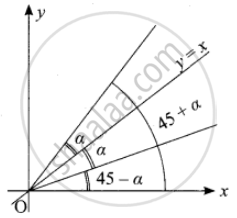Advertisements
Advertisements
प्रश्न
Prove that the equation to the straight lines through the origin, each of which makes an angle α with the straight line y = x is x2 – 2xy sec 2α + y2 = 0
उत्तर

Slope of y = x is m = tan θ = 1
⇒ θ = 45°
The new lines slopes will be
m = tan(45 + α) and m = tan (45 – α)
∴ The equations of the lines passing through the origin is given by
y = tan(45 + α)x and y = tan(45 – α)x
(i.e) y = tan(45 + α)x = 0 and y = tan(45 – α)x = 0
The combined equation is [y – tan (45 + α)x][y – tan (45 – α)x] = 0
y2 + tan(45 + α)tan(45 – α)x2 – xy[tan(45 – α) + tan(45 + α)] = 0
(i.e) `y^2 + (1 + tan alpha)/(1 - tan alpha) xx (1 - tan alpha)/(1 + tan alpha) x^2 - xy [(sin(45 - alpha))/(cos(45 - alpha)) + (sin(5 + alpha))/(cos(45 + alpha))]` = 0
(i.e) `x^2 + y^2 - xy ([sin(45 - alpha) cos(45 + alpha) + cos(45 - alpha) sin(45 + alpha)])/(cos(45 - alpha) cos(45 + alpha)`
(i.e) `x^2 + y^2 - xy ([sin (45 + 45)])/(1/2[2cos(45 - alpha) cos(45 + alpha)])` = 0
`x^2 + y^2 - (2xy)/(cos 90 + cos 2alpha)` = 0
⇒ `x^2- (2xy)/(cos 2alpha) + y^2` =0
(i.e x2 – 2xy sec 2α +y2 = 0
Aliter:
Let the slopes of the lines be m1 and m2 where
m1 = tan(45 – α)
= `(1 - tan alpha)/(1 + tan alpha)`
and
m2 = tan(45 + α)
= `(1 + tan alpha)/(1 - tan alpha)`
m1 + m2 = `(1 - tan alpha)/(1 + tan alpha) + (1 + tan alpha)/(1 - tan alpha)`
= `2(1/(cos2alpha))`
= 2sec 2α
m1m2 = `(1 - tan alpha)/(1 + tan alpha) xx (1 - tan alpha)/(1 - tan alpha)` = 1
Let the equation of lines passes through the origin
So the equations are y = m1x = 0 and y = m2x = 0
So the combined equations is (y – m1x)(y – m2x) = 0
(i.e)y2 – xy(m1 + m2) + m1m2x = 0
(i.e) y2 – xy(2sec α) + x2(1) = 0
(i.e) y2 – 2xy sec 2α + x2 = 0
APPEARS IN
संबंधित प्रश्न
Show that the equation 12x2 – 10xy + 2y2 + 14x – 5y + 2 = 0 represents a pair of straight lines and also find the separate equations of the straight lines.
Find the angle between the pair of straight lines 3x2 – 5xy – 2y2 + 17x + y + 10 = 0.
If the lines 2x – 3y – 5 = 0 and 3x – 4y – 7 = 0 are the diameters of a circle, then its centre is:
Combined equation of co-ordinate axes is:
Find the combined equation of the straight lines whose separate equations are x − 2y − 3 = 0 and x + y + 5 = 0
Show that 4x2 + 4xy + y2 − 6x − 3y − 4 = 0 represents a pair of parallel lines
Show that 2x2 + 3xy − 2y2 + 3x + y + 1 = 0 represents a pair of perpendicular lines
Show that the equation 2x2 − xy − 3y2 − 6x + 19y − 20 = 0 represents a pair of intersecting lines. Show further that the angle between them is tan−1(5)
Find the separate equation of the following pair of straight lines
3x2 + 2xy – y2 = 0
Find the separate equation of the following pair of straight lines
6(x – 1)2 + 5(x – 1)(y – 2) – 4(y – 3)2 = 0
The slope of one of the straight lines ax2 + 2hxy + by2 = 0 is three times the other, show that 3h2 = 4ab
Prove that one of the straight lines given by ax2 + 2hxy + by2 = 0 will bisect the angle between the coordinate axes if (a + b)2 = 4h2
If the pair of straight lines x2 – 2kxy – y2 = 0 bisect the angle between the pair of straight lines x2 – 2lxy – y2 = 0, Show that the later pair also bisects the angle between the former
Choose the correct alternative:
Equation of the straight line that forms an isosceles triangle with coordinate axes in the I-quadrant with perimeter `4 + 2sqrt(2)` is
Choose the correct alternative:
The coordinates of the four vertices of a quadrilateral are (−2, 4), (−1, 2), (1, 2) and (2, 4) taken in order. The equation of the line passing through the vertex (−1, 2) and dividing the quadrilateral in the equal areas is
Choose the correct alternative:
The length of ⊥ from the origin to the line `x/3 - y/4` = 1 is
The distance between the two points A and A' which lie on y = 2 such that both the line segments AB and A'B (where B is the point (2, 3)) subtend angle `π/4` at the origin, is equal to ______.
The pair of lines represented by 3ax2 + 5xy + (a2 – 2)y2 = 0 are perpendicular to each other for ______.
